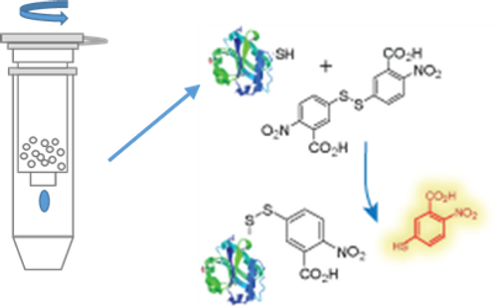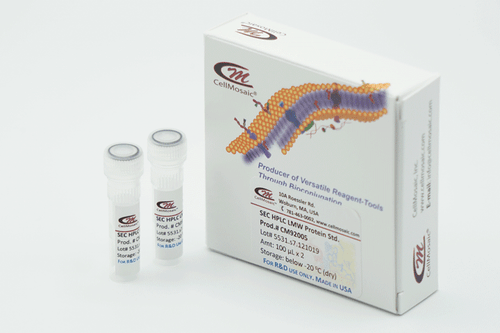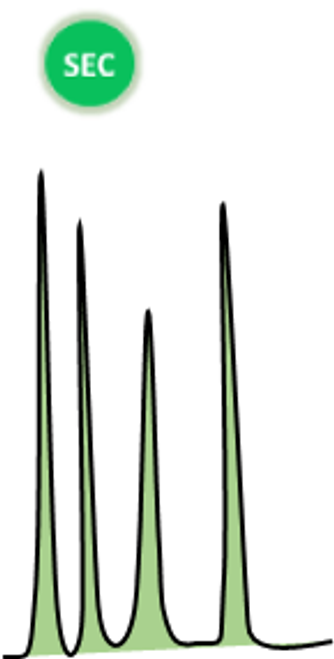Product Description
| Download Documents | |
| SDS | USER MANUAL CM11409 (1-3 mg scale) |
| USER MANUAL CM11409.01 (0.1 mg scale) | |
CellMosaic® has designed this kit to label any IgG antibody with monomethyl auristatin E (MMAE) using a valine-citruline p-aminobenzylcarbamate (VC-PAB) linker for early-stage screening of your antibody.
The kit includes maleimide-activated VC-PAB-MMAE, which can be coupled directly to the IgG following reduction and alkylation in a single step (a method developed by Seattle Genetics: Sun et al. 2005, Bioconjugate Chem., 16, 1282-1290). The product is then purified to remove any unreacted drug.
Standard Kit Configuration for CM11409 (Default: 1-3 mg per reaction, 1 Reaction included)
| Antibody Amount per Reaction | Number of Reactions in Kit | Catalog Number |
| 0.1 mg | 1 or 3 | CM11409.01x1 or CM11409.01x3 |
| 1-3 mg | 1 or 3 | CM11409x1 or CM11409x3 |
If you have any other customization needs, please provide the details above.
Drug Information
- Name: Monomethyl auristatin E (MMAE) with MC-Val-Cit-PAB linkage
- CAS number: 646502-53-6
- Mechanism of action: Inhibits cell division by blocking the polymerization of tubulin. VC-PAB linker is stable in extracellular fluid, but cleaved by cathepsin B once inside the tumor cell, thus activating the antimitotic mechanism
- Activities: Antioxidant, anti-inflammatory, anticancer, and insecticidal activities
Requirement for Antibody
- Preferably >90% pure by gel electrophoresis
- Total amount: 0.1 mg or 1-3 mg of protein content as measured by UV.
Key Features of this PerKit™
- Simple and efficient labeling of IgG with MMAE, minimizing toxin exposure.
- Features Cathepsin B cleavable VC-PAB linker (Ref. Doronina et. al. 2008, Bioconjugate Chem., 19, 1960-1963)
- Delivers an average of 4 MMAE molecules per antibody.
- Fast preparation: 4 hours total, with less than 1 hour of hands-on time.
- Includes all necessary reagents and supplies for preparation and purification.
- Achieves over 95% conjugation, free from unreacted MMAE.
- Post-conjugation services available at CellMosaic® for HPLC analysis and DAR determination.
Conjugation Chemistry

Protocol
Schematic workflow diagram for preparing antibody-MMAE conjugates, starting with 3 mg of IgG. (Reagent volume will vary if the amount of IgG is less than 3 mg).

Selected Citations from Customers who Use ADC Prepared from CM11409
1. Lofgren, Kristopher A.; Sreekumar, Sreeja; Jenkins, Charles E., Jr.; Ernzen, Kyle J.; Kenny, Paraic A. "Anti-tumor efficacy of an MMAE-conjugated antibody targeting cell surface TACE/ADAM17-cleaved Amphiregulin in breast cancer." Antibody Therapeutics 2021, 4 (4), 252-261.
2. Neetha Parameswaran, Liping Luo, Lingjun Zhang, Joel Chen, Frank P. DiFilippo, Charlie Androjna, David A. Fox, Sarah L. Ondrejka, Eric D. Hsi, Deepa Jagadeesh, Daniel J. Lindner & Feng Lin. "CD6-targeted antibody-drug conjugate as a new therapeutic agent for T cell lymphoma" Leukemia 2023, 37, 2050-2057.
3. Guido J J Kierkels, Eline van Diest, Patricia Hernández-López, Wouter Scheper, Anja C M de Bruin, Elselien Frijlink, Tineke Aarts-Riemens, Sanne F J van Dooremalen, Dennis X Beringer, Rimke Oostvogels, Lovro Kramer, Trudy Straetemans, Wolfgang Uckert, Zsolt Sebestyén, Jürgen Kuball. "Characterization and modulation of anti-αβTCR antibodies and their respective binding sites at the βTCR chain to enrich engineered T cells" Mol Ther Methods Clin Dev. 2021, 22, 388-400.
4. Zehua Sun, Xiaojie Chu, Cynthia Adams, Tatiana V Ilina, Michel Guerrero, Guowu Lin, Chuan Chen, Dontcho Jelev, Rieko Ishima, Wei Li, John W Mellors, Guillermo Calero, Dimiter S Dimitrov. "Preclinical assessment of a novel human antibody VH domain targeting mesothelin as an antibody-drug conjugate" Mol Ther Oncolytics 2023 31:100726. doi: 10.1016/j.omto.2023.09.002. eCollection 2023 Dec 19.
Frequently Asked Questions:
The list below includes FAQs that are specific to this product.
Question: Can CM11409 be used to couple a scFv (single chain variable fragment)?
Answer: CM11409 uses a reducing reagent to partially break the disulfide bonds linking two heavy chains. CM11409 can be used depending on how the fragments of the scFv are linked but, unless you know the structure of the disulfide, it is not recommended. Instead, we recommend using CM11413 to label the scFv. This kit uses the surface amine of the protein to generate the thiols needed for linking to Mc-VC-PAB-MMAE. MMAE can be released from the ADC the same way as the ADC prepared using CM11409.
Question: For the DAR estimation by UV, what are the parameters of 1.615, 0.1425, and 9 in your protocol? Could I use this formula for any antibody?
Answer: These parameters are derived from the extinction coefficient of the antibody and drug. The formula is only applicable to a standard IgG assuming a MW of 150 KDa and extinction coefficient of 210,000. If your antibody is not a full length, you can use the calculation sheet from CM11413 (https://cellmosaic.com/protein-mmae-conjugation-kit/)
Question: Can you consistently achieve a DAR value of 4 for every IgG? If not, can you ensure that the variation remains within 10%?
Answer: The kit is designed to achieve an MMAE DAR of 4 based on our standard hIgG1. Please note that the DAR value may vary depending on how the antibody concentration is determined and the quality of the antibody provided. Generally, the actual DAR may range between 3 and 5. As for the batch-to-batch variability, if the customer uses the same antibody with minimal lot-to-lot variation, ensures consistent antibody quantitation, and maintains a controlled process with minimal operator variation, the DAR can typically be kept within a 10% range.
Question: Do you have any suggestions to minimize aggregation during the conjugation process. Can we add a little Tween 20 or Tween 80 to the reducing buffer, labeling buffer, or storage/elution buffer (PBS) to prevent aggregation?
Answer: The aggregation is mainly caused by the hydrophobicity of the drugs, possibly due to stacking. To decrease the aggregation, you will have to use a water-soluble drug or a drug with a less hydrophobic linker, such as our super hydrophilic AqueaTetherÒ (AqTÒ) linker. For more information on this linker, please see https://cellmosaic.com/aqueatether-aqt-technologies/. You can also reduce aggregation by decreasing the number of drugs loaded per antibody. Adding detergent may not help in this case because it is not like a membrane protein, and micelle formation is promoted. However, you are welcome to try adding detergent to the storage buffer after purification. We do not recommend adding detergent to the reducing buffer and labeling buffer because this effects the reaction. We do have ADC stabilizing PBS buffer that you can use for long-term storage of ADC:CM02022
Question: What is the standard shipping method for CM11409? Is special handling required for Box1 and Box2 during shipping?
Answer: Box 1 is stable at room temperature for a few weeks; we use cold pack during standard shipping to prevent temperature spiking during the shipment. Box 2 is very stable at room temperature, so no special handling is needed during shipping.
Question: Is there an option for enhanced temperature-controlled shipping at an additional cost?
Answer: Yes, we can offer options for enhanced temperature-controlled shipping with a foam box option.
Question: What are the long-term storage recommendations?
Answer: For long-term storage, we recommend keeping Box1 below -20°C and Box 2 at 2-8°C. Avoid freezing Box2.
If you can’t find the answer you’re looking for or need information on general topics, please visit the main Frequently Asked Questions (FAQs) section.
Related Products
ADC Control hIgG1-MMAE (Product #: CM51100): A control ADC made with a non-binding human IgG1 subtype. This product contains an average of 4 MMAE molecules per antibody and has low endotoxin levels, making it suitable for in vitro and in vivo studies.
ADC Control Kit with VC-PAB Linker (Product #: CM11429): A negative control ADC preparation kit utilizing the VC-PAB linker.
Hydrophobic Interaction Chromatography (HIC) Buffer Set (Product#: CM02025): Designed for ADCs prepared via reduced thiols of the antibody, HIC HPLC is used to calculate the Drug-to-Antibody (DAR) and assess ADC heterogeneity. Conjugates are separated based on hydrophobicity, and antibodies with the same DAR will elute as a single peak. For typical MMAE ADCs, multiple peaks represent varying drug loads. The HIC Buffer set is accompanied by a product sheet with all of the information and methodology needed for HIC HPLC analysis. If you lack HPLC access, CellMosaic® offers sample analysis services.
Size Exclusion Chromatography (SEC) HPLC Protein Standards (Product #: CM92004 and CM92005): SEC HPLC separates the conjugates by apparent molecular weight (MW) or size in an aqueous solution. Larger MW conjugates elute earlier. Comparing SEC profiles of unlabeled IgG and ADCs allows you to estimate aggregation levels. CellMosaic® provides two SEC standards for use with any SEC column. The product sheet includes detailed methodology for running SEC HPLC analysis. If you lack HPLC access, CellMosaic® can perform the analysis for you.
ADC stabilizing PBS buffer (5x) (Product #: CM02022): This buffer contains 5x PBS and other stabilizers to prevent hydrophobic drug interactions during storage, which can cause ADC precipitation. It also preserves ADC structure lyophilization. The buffer is biocompatible and suitable for in vitro and in vivo studies.






















